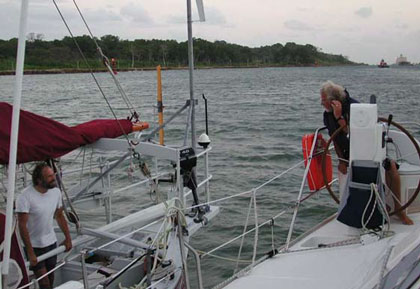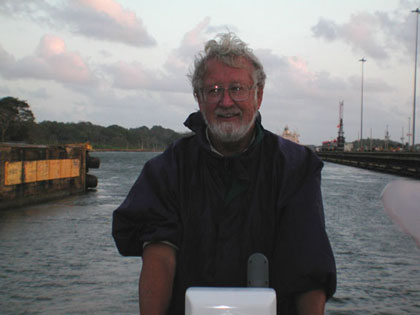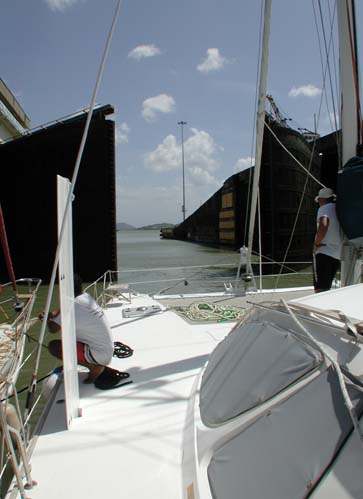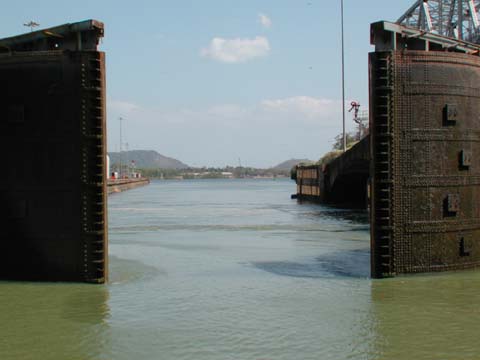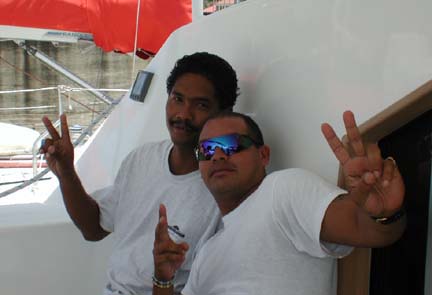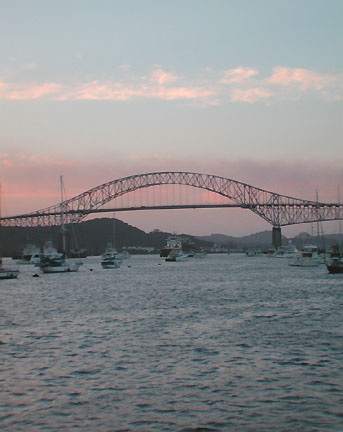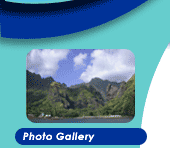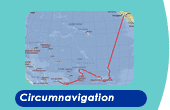Stories in this section... Colombia Pacific Bliss Transits “the
Big Ditch”
Pedro Miguel Locks. We had traveled 31 miles since the Gatun locks. Our Pilot left us via a launch and Jose, another Pilot (or perhaps “advisor”; he is a grade 2) joined us before the Pedro Miguel locks, consisting of two chambers in two lanes of locks. Jose, a lighter-complexioned Panamanian, was pumped up, full of adrenalin and self-importance—quite a contrast to our cool-headed first Pilot. He immediately asked us whether we had “connections”, impressed that a Sr. Grade A Pilot had been on board.
Jose quickly took charge, saying that Pacific Bliss would be the “lead” boat, and—as such—control all of the operations, including line handling and engine. He was obviously into control, big time! The two monohulls were now behind us, but coming up quickly. Jose’s plan called for Pacific Bliss to enter the locks against the wall, pulling along the rafted Iwalani. Then as the French boat came up, she would move into place between Pacific Bliss and the wall. He wanted us into the locks quickly before a freighter that would transit with us arrived. This procedure was not as smooth as the one we had undertaken transiting the Gatun locks. First, with only Pacific Bliss using its engines, there was less maneuverability. We had to pull in, then away from the sidewall to fit in the other boat. Our first Pilot had directed all three boat captains, and the entire nesting operation, saying not only what to do, but how to do it. Jose, however, gave vague direction and spent most of his time on his cell phone, acting important. Soon it became evident that controlling the lines from the center did not work. Our line handlers were then loaned to the other boats. Eventually, we were in position and began to move forward to the front of the locks. As the three nested yachts moved ahead, a forward line from Iwalani, on our port, caught in the walls of the locks, turning the entire raft toward port for one long, tense moment. Only quick use of Iwalani’s fat fender prevented damage to their boat. Our line handler pulled the stuck line loose, Gunter gunned the motors, and we were position again. The giant freighter came into behind us; the gates closed; and the locks began to empty. We dropped 31 feet before the gates re-opened. Since we were all tightly nested, the captains asked Jose to allow us to move on as a raft the one mile across Miraflores Lake to the Miraflores locks. Jose agreed, then ordered Gunter to push Pacific Bliss, both motors, “full speed ahead.” “Hard on the boat,” Gunter mumbled to me, but proceeded as instructed.
Miraflores Locks. These locks consist of four chambers in two lanes of two chambers each side by side, just like the Pedro Miguel locks, except that the transit involves going down in two steps. As the gates open from the last chamber, the water level inside and outside is the same, but the heavier saltwater outside of the gates sinks down under the fresh water and into the chamber and the fresh water on top surges out. The tongue of the current can be seen flowing out of the lock. Of course, upon exiting, we were given the “full speed ahead” command to overcome the current, but then, what else is new? Safely out of the locks, we unrafted again.
I went inside to check the chart for the location of the Bridge of the Americas and our exit from the channel at buoy 15 ½ to the Balboa Yacht Club. As I came out, we had rounded the bend, and there it was. The bridge spanned the Isthmus of Panama in grand style. Built in 1960 at a cost of $20 million, it is an integral part of the Pan American highway. We motored to the club’s floating dock, where we took on water and fuel, and were assigned a mooring. Our Panamanian line handlers departed, after being given a cold beer, and Tula, another Panamanian, helped us secure our mooring, the first of many times he helped us out at the Balboa Yacht Club.
Sitting in the cockpit of Pacific Bliss as the sun began to lower over the mountains near the Bridge of the Americas, Phyllis, Richard, Gunter and I finally breathed a deep sigh of relief. Then came a cheer and a toast. We did it! It has been one very long, sometimes tense, always exhilarating, day. In a little over twelve hours and 50 miles, we have traveled to the other side of the “Big Ditch” into a very different ocean. The winds and seas seem calmer here, and the tropical air seems fresher and cooler, or is it just my imagination? I feel GREAT! And as for Pacific Bliss, she is rocking and rolling less in this calmer anchorage. She deserves a rest—and a good cleaning with fresh water, inside and out. I know that she will delight in this ocean and provide her owners with many moments of bliss, because this is her namesake, Pacific Bliss.
Click here for more photos of the transit located in the Photo Gallery. Iwalani means “heavenly sea bird” in Hawaiian. She is the realization of a dream by her owners, who took 10 years to build her. For the story of her circumnavigation, go to their website at www.worldvoyagers.com or CLICK HERE. She is currently moored in the Balboa Yacht Club as well. journal28page3.html |
|
|
|
|
